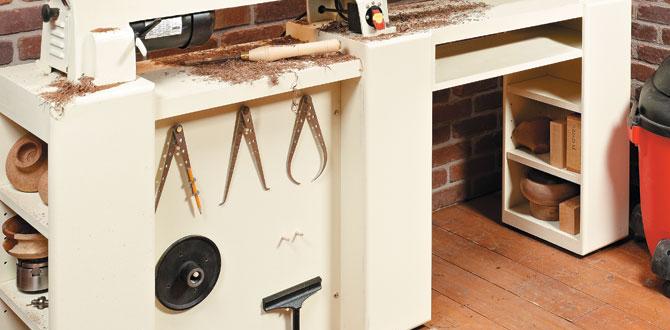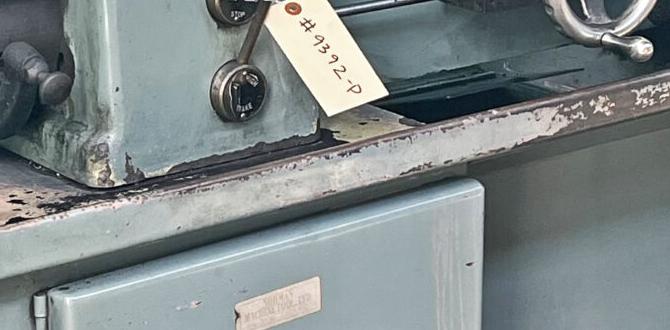Wood lathe dust extraction system is an indispensable tool for any woodworker who values their health, workspace, and the quality of their finished projects. Turning wood on a lathe inherently generates a significant amount of fine dust and chips. Without an effective system to manage this byproduct, your workshop quickly becomes a hazardous and unpleasant environment. The fine particles can irritate your lungs, eyes, and skin, leading to long-term respiratory problems. Furthermore, this airborne debris can settle on your workpiece, ruining a smooth finish, and clog up your lathe’s moving parts, potentially leading to premature wear and tear. Investing in a robust wood lathe dust extraction system is not just about convenience; it’s about creating a safer, healthier, and more productive working environment.
The Dangers of Wood Dust
Before delving into the solutions, it’s crucial to understand why wood dust is such a pervasive problem. Different wood species produce dust with varying particle sizes and chemical compositions, but all can pose health risks. Hardwoods, like oak and maple, tend to produce finer dust which is more easily inhaled deep into the lungs. Softwoods, such as pine, can create larger chips that, while perhaps less of a deep lung irritant, still contribute to airborne particulate matter and can cause skin and eye irritation.
Beyond immediate discomfort, prolonged exposure to wood dust has been linked to serious health issues. Occupational asthma, allergic reactions, and even certain types of cancer are recognized risks for individuals regularly exposed to wood dust without adequate protection. This is why a comprehensive dust collection strategy is paramount, especially when undertaking demanding woodworking tasks like those involved in woodturning.
Components of an Effective Wood Lathe Dust System
A truly effective wood lathe dust extraction system is typically comprised of several key components working in harmony:
The Dust Collector: This is the heart of the system. It’s a powerful motor and fan unit designed to create suction, drawing air and debris into the system. Dust collectors vary in size and power (measured in horsepower or CFM – Cubic Feet per Minute), and the choice depends on the scale of your operation and the types of woodworking you do. For a lathe setup, a smaller to medium-sized collector is usually sufficient.
Hosing and Fittings: This is the network that transports the dust from the source to the collector. The diameter of the hosing is critical; too small, and you restrict airflow and velocity, leading to clogs. Too large, and the velocity of air might not be enough to carry the heavier chips effectively. Smooth interior surfaces are essential to minimize dust buildup and resistance.
Collection Bags or Receptacle: Most dust collectors use either disposable filter bags or a larger drum-style receptacle. The collector separates the bulk of the dust from the air, which is then filtered and exhausted. The capacity of the bag or drum dictates how often you’ll need to empty it, which is a routine maintenance task.
Filtration: The air that is expelled from the dust collector needs to be cleaned. Higher-quality dust collectors feature multi-stage filtration, often including a fine filter that captures even microscopic particles before the air is released back into your workshop. HEPA filters are the gold standard for capturing the smallest, most hazardous particles.
Designing Your Wood Lathe Dust Extraction System
Setting up an optimal wood lathe dust extraction system requires careful planning. The primary goal is to position the dust collection point as close as possible to the source of the dust generation – the spinning workpiece.
1. Proximity is Key: A hood or shroud that either attaches directly to the lathe or is mounted nearby, directly capturing the dust as it’s thrown off the wood by centrifugal force, is the most effective approach. There are many commercially available dust collection hoods designed specifically for lathes, or you can even design and build your own using acrylic or plywood.
2. Airflow Direction: Consider the natural airflow created by the spinning lathe. The dust is generally thrown outwards. Your dust collection hood should be positioned to intercept this outward flow.
3. Hose Routing: Route your hosing in a way that avoids kinks and sharp bends, which can impede airflow and create dust traps. Use flexible, smooth-walled hoses whenever possible. Consider quick-disconnect fittings so you can easily move the hose between different tools or dust collection points in your shop.
4. Machine vs. Portable Collectors: For dedicated lathe work, a machine-mounted dust collector might be ideal. However, if you have multiple tools that generate dust, a portable dust collector that can be moved from one machine to another offers greater versatility.
Maintenance for Optimal Performance
Even the best wood lathe dust extraction system requires regular maintenance to perform at its peak. Neglecting this can drastically reduce its effectiveness and even create new problems.
Emptying Collection Bags/Receptacles: Don’t let the dust bag or drum get completely full. A half-full bag can significantly reduce suction. Emptying it regularly is crucial.
Cleaning Filters: Clogged filters severely restrict airflow. Most filters can be cleaned by rapping them or using compressed air. Follow the manufacturer’s recommendations for your specific filter type. Disposable filters will eventually need to be replaced.
Inspecting Hoses and Fittings: Periodically check your hoses for rips, tears, or blockages. Ensure all fittings are secure and creating an airtight seal.
Motor Maintenance: While less frequent, check the dust collector’s motor for any signs of overheating or unusual noise. Keep the motor vents clear of dust.
Ultimately, a well-designed and maintained wood lathe dust extraction system is an investment that pays dividends in safety, health, and the quality of your woodworking. By understanding the risks of wood dust and implementing a proper collection strategy, you can transform your workshop into a cleaner, safer, and more enjoyable space to hone your craft.







